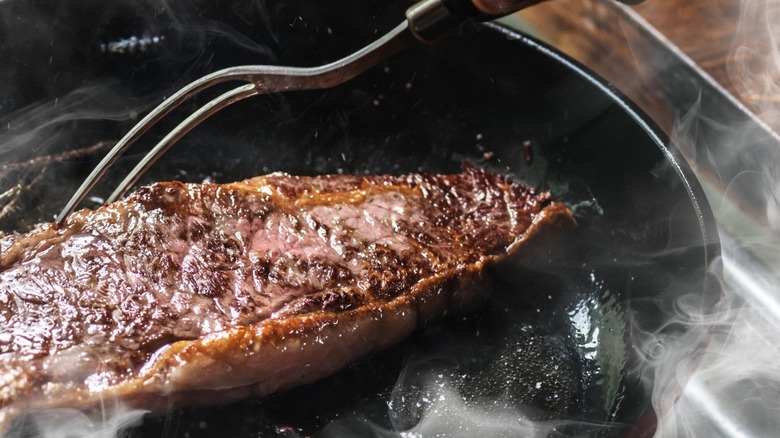This Beginner-Friendly Method Of Searing Steak Seems Too Good To Be True, But It Works
Let's say you'd like to enjoy a good steak at home, but you don't have a grill — maybe you live in an apartment building. And you're certainly not going to do any silly cooking hacks like putting the steak in a toaster or even trying to cook steak in an air fryer. But gosh, pan-searing sure can be intimidating, right? When you're going to cook a steak, the language used to describe the temperature of the pan is so aggressive: "ripping hot," "screaming hot," things of that nature. And the mighty sizzle of meat meeting pan will be loud enough to wake your dog napping in the next room — and that's before the smoke alarm goes off and/or grease gets spattered all over your forearms. (It's not as dangerous as deep frying, but it's still pretty daunting.) Is there any way to cook a steak that's maybe a little less intimidating for beginners? Why not try cold searing?
We asked Robbie Shoults, celebrity chef and third-generation owner of Bear Creek Smokehouse in Texas, to walk us through the process. "As you begin the cooking process, place the steak in a cold skillet and turn the heat on high," Shoults advised. "Flip the steak with tongs about every two minutes or so, and once you've made several flips, you can reduce your heat to medium. Use a meat thermometer to achieve your desired doneness."
By doing this, you can not only avoid smoke and spatter, but it cooks the steak more evenly than a hot sear. Shoults also added that "cold searing a steak in a skillet requires minimal gadgets and cookware compared to cooking a steak outside on your smoker grill."
How to prepare your steak for a cold sear
So what cuts of steak work best for a cold sear? Robbie Shoults suggests something with plenty of marbling. "Ribeyes, T-bones, and strip steaks work best for cold searing as they are well marbled and have enough fat to render a flavorful sear," he said. Ribeyes and strip steaks are also both considered some of the easiest cuts of steak to cook by experts.
Marbling provides another bonus, too. If you choose a steak that's well-marbled, "it creates its own oil to help prevent sticking," Shoults explained. This means you don't need to add any oil or fat to the pan.
There are a few steps you need to take to make sure your cold sear comes out just right. "Cold searing will work best if the meat is allowed to come up to room temperature and is patted dry with a paper towel before starting the cooking process," Shoults said. "Removing excess moisture from the steak will help with the whole browning process, and once this is done, season away!" As with any other kind of meat, patting away moisture will aid the Maillard reaction and give you that wonderfully flavorful crust you crave.

